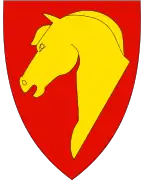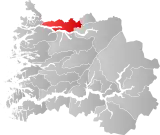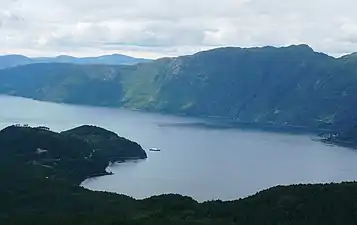Eid Municipality
Eid kommune | |
|---|---|
 View of the Eidsfjorden | |
 Flag  Coat of arms | |
 Sogn og Fjordane within Norway | |
 Eid within Sogn og Fjordane | |
| Coordinates: 61°54′41″N 06°02′14″E / 61.91139°N 6.03722°E | |
| Country | Norway |
| County | Sogn og Fjordane |
| District | Nordfjord |
| Established | 1 Jan 1838 |
| • Created as | Formannskapsdistrikt |
| Disestablished | 1 Jan 2020 |
| • Succeeded by | Stad Municipality |
| Administrative centre | Nordfjordeid |
| Government | |
| • Mayor (2011-2019) | Alfred Bjørlo (V) |
| Area (upon dissolution) | |
| • Total | 469.24 km2 (181.17 sq mi) |
| • Land | 420.22 km2 (162.25 sq mi) |
| • Water | 49.02 km2 (18.93 sq mi) 10.4% |
| • Rank | #215 in Norway |
| Population (2018) | |
| • Total | 6,157 |
| • Rank | #168 in Norway |
| • Density | 14.7/km2 (38/sq mi) |
| • Change (10 years) | |
| Demonyms | Eidar Eider[1] |
| Official language | |
| • Norwegian form | Nynorsk |
| Time zone | UTC+01:00 (CET) |
| • Summer (DST) | UTC+02:00 (CEST) |
| ISO 3166 code | NO-1443[3] |
Eid is a former municipality in the county of Sogn og Fjordane, Norway. It was located in the traditional district of Nordfjord. The village of Nordfjordeid was the administrative center of the municipality. Other larger villages in Eid included Mogrenda, Stårheim, Haugen, Kjølsdalen, Heggjabygda, and Lote.
At the time of its dissolution in 2020, the 469-square-kilometre (181 sq mi) municipality is the 215th largest by area out of the 422 municipalities in Norway. Eid is the 168th most populous municipality in Norway with a population of 6,157. The municipality's population density is 14.7 inhabitants per square kilometre (38/sq mi) and its population has increased by 5.2% over the last decade.[4][5]
Eid was known for its opera, fjord horses, shopping, and hiking opportunities. As in the rest of the region, agriculture was very important here, but trade and industry were also important. Frislid Konfeksjon (textiles) and the Hellesøy Nordfjord shipyard among others are located in Eid.
Nordfjordeid's schools include the folk high school, which offers courses linked to Fjord horses and provides the only circus education in Norway. There is also the Norwegian Fjord Horse Centre (Norsk Fjordhestsenter) in Eid. Its focus is in boosting the breed's standing in Norway and elsewhere.[6]
General information


Eid was established as a municipality on 1 January 1838 (see formannskapsdistrikt law). The original municipality was identical to the Eid parish (prestegjeld) with the sub-parishes (sokn) of Hornindal, Eid, and Stårheim.[7] On 1 January 1867, the eastern district of Hornindal was separated from Eid to form its own municipality. This split left the two remaining sub-parishes of the municipality of Eid with a population of 2,918.[8]
During the 1960s, there were many municipal mergers across Norway due to the work of the Schei Committee. On 1 January 1965, the neighboring municipalities of Davik and Hornindal were dissolved and split up among their neighbors. Eid municipality gained all of Davik that was north of the Nordfjorden and east of and including the village of Lefdal. (Population in that area was 654.[8]) All of Hornindal municipality west of and including the villages of Navelsaker and Holmøyvik (population: 310) was also merged into Eid. After this merger, Eid's total population was 4,532.[8] At this point, Eid gained a third sub-parish from the former municipality of Davik: Kjølsdalen. Then on 1 January 1992, the village of Lote and its surrounding area (population: 152) was transferred from Gloppen Municipality to Eid.[8]
On 1 January 2020, Eid Municipality ceased to exist when it was merged with the neighboring Selje Municipality and the Bryggja-Totland area of Vågsøy Municipality to form the new Stad Municipality.[9][10]
Name
The municipality (originally the parish) is named after the Eidsfjorden (Old Norse: Øygir) since it is a central geographical feature of the area. The fjord is a branch off the main Nordfjorden. The fjord name likely comes from an old river name (now called Eidselva). The name of the river was probably derived from the word aug or ǫfugr which both mean "turned the wrong way" or "backwards". This is likely because the river Eidselva meanders back and forth and from certain points it can seem to run backwards. Over the centuries, the name was corrupted so that it became more like the word Eid which is a Norwegian word that is derived from eið which means "isthmus".[11]
Coat of arms
The coat of arms was granted on 26 April 1986 and they were in use until 1 January 2020 when the municipality ceased to exist. The official blazon is "Gules, a horse head couped Or" (Norwegian: På raud grunn eit gull hestehovud). This means the arms have a red field (background) and the charge is the head of a fjord horse (Fjording), cut cleanly at the neck. The charge has a tincture of Or which means it is commonly colored yellow, but if it is made out of metal, then gold is used. The region is well known for its own breed of horses, called the Fjording, that are very common and popular in the area. The Fjording is characterised by its white and black mane. The arms were designed by Inge Rotevatn. The municipal flag has the same design as the coat of arms.[12][13][14]
Churches
The Church of Norway had three parishes (sokn) within the municipality of Eid. It is part of the Nordfjord prosti (deanery) in the Diocese of Bjørgvin.[7][15]
| Parish (sokn) | Church name | Location of the church | Year built |
|---|---|---|---|
| Eid | Eid Church | Nordfjordeid | 1849 |
| Heggjabygda Church | Heggjabygda | 1936 | |
| Kjølsdalen | Kjølsdalen Church | Kjølsdalen | 1940 |
| Stårheim | Stårheim Church | Stårheim | 1864 |
Government
While it existed, this municipality was responsible for primary education (through 10th grade), outpatient health services, senior citizen services, unemployment, social services, zoning, economic development, and municipal roads. During its existence, this municipality was governed by a municipal council of directly elected representatives. The mayor was indirectly elected by a vote of the municipal council.[16] The municipality was under the jurisdiction of the Sogn og Fjordane District Court and the Gulating Court of Appeal.
Municipal council
The municipal council (Kommunestyre) of Eid was made up of 29 representatives that were elected to four year terms. The party breakdown of the final municipal council was as follows:
| Party name (in Nynorsk) | Number of representatives | |
|---|---|---|
| Labour Party (Arbeidarpartiet) | 4 | |
| Progress Party (Framstegspartiet) | 1 | |
| Conservative Party (Høgre) | 4 | |
| Christian Democratic Party (Kristeleg Folkeparti) | 1 | |
| Centre Party (Senterpartiet) | 9 | |
| Socialist Left Party (Sosialistisk Venstreparti) | 1 | |
| Liberal Party (Venstre) | 9 | |
| Total number of members: | 29 | |
| Party name (in Nynorsk) | Number of representatives | |
|---|---|---|
| Labour Party (Arbeidarpartiet) | 2 | |
| Progress Party (Framstegspartiet) | 2 | |
| Conservative Party (Høgre) | 4 | |
| Christian Democratic Party (Kristeleg Folkeparti) | 1 | |
| Centre Party (Senterpartiet) | 6 | |
| Socialist Left Party (Sosialistisk Venstreparti) | 1 | |
| Liberal Party (Venstre) | 13 | |
| Total number of members: | 29 | |
| Party name (in Nynorsk) | Number of representatives | |
|---|---|---|
| Labour Party (Arbeidarpartiet) | 8 | |
| Progress Party (Framstegspartiet) | 2 | |
| Conservative Party (Høgre) | 6 | |
| Christian Democratic Party (Kristeleg Folkeparti) | 2 | |
| Centre Party (Senterpartiet) | 7 | |
| Socialist Left Party (Sosialistisk Venstreparti) | 1 | |
| Liberal Party (Venstre) | 3 | |
| Total number of members: | 29 | |
| Party name (in Nynorsk) | Number of representatives | |
|---|---|---|
| Labour Party (Arbeidarpartiet) | 5 | |
| Progress Party (Framstegspartiet) | 2 | |
| Conservative Party (Høgre) | 4 | |
| Christian Democratic Party (Kristeleg Folkeparti) | 2 | |
| Centre Party (Senterpartiet) | 8 | |
| Socialist Left Party (Sosialistisk Venstreparti) | 2 | |
| Liberal Party (Venstre) | 6 | |
| Total number of members: | 29 | |
| Party name (in Nynorsk) | Number of representatives | |
|---|---|---|
| Labour Party (Arbeidarpartiet) | 4 | |
| Progress Party (Framstegspartiet) | 2 | |
| Conservative Party (Høgre) | 10 | |
| Christian Democratic Party (Kristeleg Folkeparti) | 2 | |
| Centre Party (Senterpartiet) | 9 | |
| Socialist Left Party (Sosialistisk Venstreparti) | 2 | |
| Liberal Party (Venstre) | 4 | |
| Total number of members: | 33 | |
| Party name (in Nynorsk) | Number of representatives | |
|---|---|---|
| Labour Party (Arbeidarpartiet) | 4 | |
| Progress Party (Framstegspartiet) | 1 | |
| Conservative Party (Høgre) | 9 | |
| Christian Democratic Party (Kristeleg Folkeparti) | 2 | |
| Centre Party (Senterpartiet) | 11 | |
| Socialist Left Party (Sosialistisk Venstreparti) | 1 | |
| Liberal Party (Venstre) | 5 | |
| Total number of members: | 33 | |
| Party name (in Nynorsk) | Number of representatives | |
|---|---|---|
| Labour Party (Arbeidarpartiet) | 5 | |
| Progress Party (Framstegspartiet) | 1 | |
| Conservative Party (Høgre) | 7 | |
| Christian Democratic Party (Kristeleg Folkeparti) | 2 | |
| Centre Party (Senterpartiet) | 11 | |
| Socialist Left Party (Sosialistisk Venstreparti) | 2 | |
| Liberal Party (Venstre) | 5 | |
| Total number of members: | 33 | |
| Party name (in Nynorsk) | Number of representatives | |
|---|---|---|
| Labour Party (Arbeidarpartiet) | 8 | |
| Conservative Party (Høgre) | 8 | |
| Christian Democratic Party (Kristeleg Folkeparti) | 3 | |
| Centre Party (Senterpartiet) | 9 | |
| Socialist Left Party (Sosialistisk Venstreparti) | 1 | |
| Liberal Party (Venstre) | 4 | |
| Total number of members: | 33 | |
| Party name (in Nynorsk) | Number of representatives | |
|---|---|---|
| Labour Party (Arbeidarpartiet) | 8 | |
| Conservative Party (Høgre) | 8 | |
| Christian Democratic Party (Kristeleg Folkeparti) | 4 | |
| Centre Party (Senterpartiet) | 9 | |
| Liberal Party (Venstre) | 4 | |
| Total number of members: | 33 | |
| Party name (in Nynorsk) | Number of representatives | |
|---|---|---|
| Labour Party (Arbeidarpartiet) | 6 | |
| Conservative Party (Høgre) | 8 | |
| Christian Democratic Party (Kristeleg Folkeparti) | 4 | |
| Centre Party (Senterpartiet) | 10 | |
| Liberal Party (Venstre) | 4 | |
| Non-party list (Upolitisk liste) | 1 | |
| Total number of members: | 33 | |
| Party name (in Nynorsk) | Number of representatives | |
|---|---|---|
| Labour Party (Arbeidarpartiet) | 3 | |
| Conservative Party (Høgre) | 5 | |
| Christian Democratic Party (Kristeleg Folkeparti) | 4 | |
| Centre Party (Senterpartiet) | 14 | |
| Liberal Party (Venstre) | 2 | |
| Non-party list (Upolitisk Liste) | 1 | |
| Total number of members: | 29 | |
| Party name (in Nynorsk) | Number of representatives | |
|---|---|---|
| Labour Party (Arbeidarpartiet) | 4 | |
| Conservative Party (Høgre) | 2 | |
| Christian Democratic Party (Kristeleg Folkeparti) | 3 | |
| Centre Party (Senterpartiet) | 13 | |
| Liberal Party (Venstre) | 7 | |
| Total number of members: | 29 | |
| Party name (in Nynorsk) | Number of representatives | |
|---|---|---|
| Labour Party (Arbeidarpartiet) | 7 | |
| Conservative Party (Høgre) | 3 | |
| Christian Democratic Party (Kristeleg Folkeparti) | 3 | |
| Centre Party (Senterpartiet) | 10 | |
| Liberal Party (Venstre) | 6 | |
| Total number of members: | 29 | |
| Party name (in Nynorsk) | Number of representatives | |
|---|---|---|
| Labour Party (Arbeidarpartiet) | 7 | |
| Conservative Party (Høgre) | 3 | |
| Christian Democratic Party (Kristeleg Folkeparti) | 3 | |
| Centre Party (Senterpartiet) | 10 | |
| Liberal Party (Venstre) | 6 | |
| Total number of members: | 29 | |
| Party name (in Nynorsk) | Number of representatives | |
|---|---|---|
| Labour Party (Arbeidarpartiet) | 6 | |
| Conservative Party (Høgre) | 2 | |
| Christian Democratic Party (Kristeleg Folkeparti) | 3 | |
| Centre Party (Senterpartiet) | 7 | |
| Liberal Party (Venstre) | 6 | |
| Local List(s) (Lokale lister) | 5 | |
| Total number of members: | 29 | |
| Party name (in Nynorsk) | Number of representatives | |
|---|---|---|
| Labour Party (Arbeidarpartiet) | 6 | |
| Conservative Party (Høgre) | 2 | |
| Christian Democratic Party (Kristeleg Folkeparti) | 2 | |
| Joint List(s) of Non-Socialist Parties (Borgarlege Felleslister) | 7 | |
| Local List(s) (Lokale lister) | 12 | |
| Total number of members: | 29 | |
| Party name (in Nynorsk) | Number of representatives | |
|---|---|---|
| Labour Party (Arbeidarpartiet) | 6 | |
| Liberal Party (Venstre) | 7 | |
| Joint List(s) of Non-Socialist Parties (Borgarlege Felleslister) | 4 | |
| Local List(s) (Lokale lister) | 11 | |
| Total number of members: | 28 | |
| Party name (in Nynorsk) | Number of representatives | |
|---|---|---|
| Labour Party (Arbeidarpartiet) | 4 | |
| Joint List(s) of Non-Socialist Parties (Borgarlege Felleslister) | 9 | |
| Local List(s) (Lokale lister) | 15 | |
| Total number of members: | 28 | |
| Party name (in Nynorsk) | Number of representatives | |
|---|---|---|
| Labour Party (Arbeidarpartiet) | 7 | |
| Local List(s) (Lokale lister) | 21 | |
| Total number of members: | 28 | |
| Party name (in Nynorsk) | Number of representatives | |
|---|---|---|
| Labour Party (Arbeidarpartiet) | 4 | |
| Farmers' Party (Bondepartiet) | 3 | |
| Liberal Party (Venstre) | 5 | |
| Local List(s) (Lokale lister) | 8 | |
| Total number of members: | 28 | |
| Note: Due to the German occupation of Norway during World War II, no elections were held for new municipal councils until after the war ended in 1945. | ||
Mayors
- 1838-1841: Johan Herman Lie
- 1842-1843: Tollef Rød
- 1844-1851: Johan Herman Lie
- 1851-1852: Martinus Bjørlo
- 1852-1857: Jens J. Finckenhagen
- 1858-1864: Eirik Løken
- 1864-1867: Anders Os
- 1868-1869: Hans Sandboe Schølberg
- 1870-1871: Wirik Løken
- 1871-1879: S. Kvale
- 1880-1881: Kristian Blom
- 1882-1897: Rasmus Møklebust (V)
- 1898-1916: John Myklebust (V)
- 1917-1934: Anders Hjelle (V)
- 1935-1935: John Myklebust (V)
- 1935-1940: Olav Os (Bp)
- 1941–1943: Arnt Hjelle (NS)
- 1943–1945: Peder Sporsem (NS)
- 1947-1947: Olav Os (Bp)
- 1948-1963: Berge Smørdal (Bp)
- 1963-1971: Per Roti (Sp)
- 1972-1983: Lars Myrold (Sp)
- 1984-1991: Knut Hildenes (Sp)
- 1992-1993: Kjell Nøstdal (V)
- 1994-2003: Kristen Hundeide (H)
- 2003-2005: Gunvald Ludvigsen (V)
- 2005-2011: Sonja Edvardsen (Ap)
- 2011-2019: Alfred Bjørlo (V)[35]
Geography


The municipality of Eid was located in the northernmost part of Sogn og Fjordane county. It was located along the northern shores of the Nordfjorden and it surrounded the Eidsfjorden branch off of the main Nordfjorden. Eid was bordered to the west by the municipality of Vågsøy, to the south by the municipalities of Bremanger and Gloppen, to the east by the municipalities of Stryn and Hornindal, and to the north by the municipalities of Volda and Vanylven in Møre og Romsdal county.
The lake Hornindalsvatnet, the deepest lake in Europe, was partially located in Eid municipality.
Notable people
- Sophus Lie (1842–1899), a mathematician
- Azar Karadaş, a football player
- Harald Aabrekk, a soccer coach
See also
References
- ↑ "Navn på steder og personer: Innbyggjarnamn" (in Norwegian). Språkrådet.
- ↑ "Forskrift om målvedtak i kommunar og fylkeskommunar" (in Norwegian). Lovdata.no.
- ↑ Bolstad, Erik; Thorsnæs, Geir, eds. (26 January 2023). "Kommunenummer". Store norske leksikon (in Norwegian). Kunnskapsforlaget.
- ↑ Statistisk sentralbyrå (2018). "Table: 06913: Population 1 January and population changes during the calendar year (M)" (in Norwegian). Retrieved 5 October 2019.
- ↑ Statistisk sentralbyrå. "09280: Area of land and fresh water (km²) (M)" (in Norwegian). Retrieved 5 October 2019.
- ↑ "Eid". Nordfjord.info. Archived from the original on 21 July 2011. Retrieved 2 August 2008.
- 1 2 Natvik, Oddvar (9 February 2005). "Some historical data on the 26 Kommunes". Archived from the original on 24 July 2011.
- 1 2 3 4 Jukvam, Dag (1999). Historisk oversikt over endringer i kommune- og fylkesinndelingen (PDF) (in Norwegian). Statistisk sentralbyrå. ISBN 9788253746845.
- ↑ "Stad 2020: Eid og Selje i ny kommune" (in Norwegian). Retrieved 21 October 2017.
- ↑ "Bryggja inn i Stad kommune" (in Norwegian). Nye Stad kommune. Retrieved 5 October 2019.
- ↑ Rygh, Oluf (1919). Norske gaardnavne: Nordre Bergenhus amt (in Norwegian) (12 ed.). Kristiania, Norge: W. C. Fabritius & sønners bogtrikkeri. pp. 427–428.
- ↑ "Civic heraldry of Norway - Norske Kommunevåpen". Heraldry of the World. Retrieved 29 May 2023.
- ↑ "Eid, Sogn og Fjordane (Norway)". Flags of the World. Retrieved 29 May 2023.
- ↑ "Godkjenning av våpen og flagg". Lovdata.no (in Norwegian). Norges kommunal- og arbeidsdepartementet. 25 April 1986. Retrieved 29 May 2023.
- ↑ "Eid kirkelige fellesråd" (in Norwegian). Den Norske Kirke.
- ↑ Hansen, Tore; Vabo, Signy Irene, eds. (20 September 2022). "kommunestyre". Store norske leksikon (in Norwegian). Kunnskapsforlaget. Retrieved 1 January 2023.
- 1 2 3 4 "Table: 04813: Members of the local councils, by party/electoral list at the Municipal Council election (M)" (in Norwegian). Statistics Norway.
- ↑ "Tall for Norge: Kommunestyrevalg 2011 - Sogn og Fjordane" (in Norwegian). Statistics Norway. Retrieved 19 October 2019.
- ↑ "Kommunestyrevalget 1995" (PDF) (in Norwegian). Oslo-Kongsvinger: Statistisk sentralbyrå. 1996. Retrieved 16 February 2020.
- ↑ "Kommunestyrevalget 1991" (PDF) (in Norwegian). Oslo-Kongsvinger: Statistisk sentralbyrå. 1993. Retrieved 16 February 2020.
- ↑ "Kommunestyrevalget 1987" (PDF) (in Norwegian). Oslo-Kongsvinger: Statistisk sentralbyrå. 1988. Retrieved 16 February 2020.
- ↑ "Kommunestyrevalget 1983" (PDF) (in Norwegian). Oslo-Kongsvinger: Statistisk sentralbyrå. 1984. Retrieved 1 May 2020.
- ↑ "Kommunestyrevalget 1979" (PDF) (in Norwegian). Oslo: Statistisk sentralbyrå. 1979. Retrieved 10 May 2020.
- ↑ "Kommunevalgene 1975" (PDF) (in Norwegian). Oslo: Statistisk sentralbyrå. 1977. Retrieved 10 May 2020.
- ↑ "Kommunevalgene 1972" (PDF) (in Norwegian). Oslo: Statistisk sentralbyrå. 1973. Retrieved 10 May 2020.
- ↑ "Kommunevalgene 1967" (PDF) (in Norwegian). Oslo: Statistisk sentralbyrå. 1967. Retrieved 10 May 2020.
- ↑ "Kommunevalgene 1963" (PDF) (in Norwegian). Oslo: Statistisk sentralbyrå. 1964. Retrieved 10 May 2020.
- ↑ "Kommunevalgene og Ordførervalgene 1959" (PDF) (in Norwegian). Oslo: Statistisk sentralbyrå. 1960. Retrieved 10 May 2020.
- ↑ "Kommunevalgene og Ordførervalgene 1955" (PDF) (in Norwegian). Oslo: Statistisk sentralbyrå. 1957. Retrieved 10 May 2020.
- ↑ "Kommunevalgene og Ordførervalgene 1951" (PDF) (in Norwegian). Oslo: Statistisk sentralbyrå. 1952. Retrieved 10 May 2020.
- ↑ "Kommunevalgene og Ordførervalgene 1947" (PDF) (in Norwegian). Oslo: Statistisk sentralbyrå. 1948. Retrieved 10 May 2020.
- ↑ "Kommunevalgene og Ordførervalgene 1945" (PDF) (in Norwegian). Oslo: Statistisk sentralbyrå. 1947. Retrieved 10 May 2020.
- ↑ "Kommunevalgene og Ordførervalgene 1937" (PDF) (in Norwegian). Oslo: Statistisk sentralbyrå. 1938. Retrieved 11 May 2020.
- ↑ "Ordførarar i Eid kommune". NRK Fylkesliksikon (in Norwegian). 20 November 2003. Retrieved 29 May 2023.
- ↑ Eid Kommune. "Ordføraren" (in Norwegian). Archived from the original on 16 February 2012. Retrieved 2 August 2008.
External links
 Sogn og Fjordane travel guide from Wikivoyage
Sogn og Fjordane travel guide from Wikivoyage

